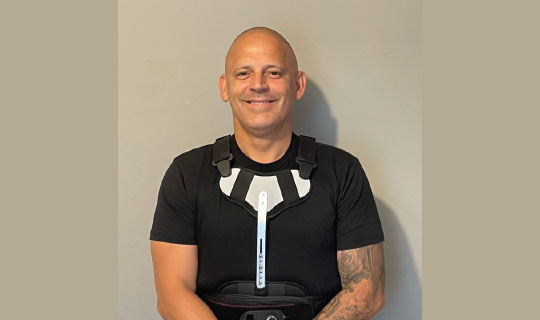"I could barely walk before. Now I'm walking like a normal human with my arms swinging."

Retired police officer Obdulio (Jay) Serrano, Jr., remembers the on-duty incident well. “It was a bad domestic call,” says the 52-year-old Waretown resident, who served on the Lakewood force. “After locking up one guy, I tripped over another guy and fell on my gun side.” The tumble damaged three discs between vertebrae in Jay’s lower back and required fusion surgery in 2012 to “weld” that part of the spine into a single solid bone.
The surgery restored some lost sensation and relieved some pain and tingling but still left Jay with a curved spine, nerve and muscle damage and pain in his right leg—“like someone driving a spike up my heel,” he says. Additional back injuries after a fall into a sinkhole during an off-duty assignment forced him to retire as a cop.


Jay went through nine years of pain, hobbling and 28 spinal injections to relieve the pain. Then he was referred to Monmouth Medical Center (MMC), where he met spine surgeon Steve Paragioudakis, MD, who, with spine surgeon Marc Menkowitz, MD, had recently treated their milestone 100th patient with a cutting-edge technology called the Globus Medical ExcelsiusGPS robot for minimally invasive spine surgery.
Precise Procedures
MMC was the second hospital in New Jersey to use the technology, and few surgeons can match Dr. Menkowitz’s and Dr. Paragioudakis’s expertise and experience with it. They perform the majority of their robotic cases together, treating debilitating conditions like damaged discs, degenerative disc disease, spinal stenosis, scoliosis and other back problems.
The ExcelsiusGPS system combines a robotic arm with computer-assisted navigation. CT scan and X-ray images of the spine taken prior to a procedure create a surgical plan that helps the physician guide the robotic arm to a specific area of the spine. The surgeon views the procedure on a monitor that provides real-time feedback. “This is the wave of the future,” says Dr. Paragioudakis.
Using this technology, procedures are generally more accurate and less invasive than traditional surgery. “We can be precise to the millimeter,” Dr. Menkowitz says. “Once we navigate to where we want to be in the spine, the system locks us into the surgical pathway.”
With its precision and smaller incisions than with traditional surgery, the procedure generally involves less blood loss, tissue damage and scar tissue, allowing patients to recover more quickly and with less pain, says Dr. Menkowitz. The robotic technology allows surgeons to operate on different areas of the spine without needing to reposition the patient, which means less time under anesthesia, says Dr. Paragioudakis. This also contributes to quicker recovery, and hospital stays tend to decrease by about a day. The patient is also exposed to less radiation because fewer X-rays are needed to guide procedures.
Since undergoing the robotic surgery in April 2021, Jay’s leg pain has subsided, nerves and muscles are healing and symptoms related to poor circulation such as hair loss on his right leg have been alleviated. He even gained an inch in height because his spine is straighter. “I could barely walk before,” Jay says. “Now I’m walking like a normal human with my arms swinging. They’re beautiful people at MMC, and the strides they’ve made in spine surgery are amazing.”
To learn more, visit the Spine Center at Monmouth Medical Center or call 888-724-7123.